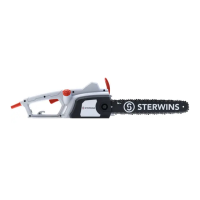18
RU
KZ
EN
chain a long the top of the guide bar. This can cause the chain to instantly stop. The chain force is then
reversed, causing the saw to move in the opposite direction, sending the saw straight back toward the
operator.
Either of these reactions may cause you to lose control of the saw which could result in serious personal
injury. Do not rely exclusively upon the safety devices built into your saw. Many factors inuence the
occurrence and force of the kickback reaction. These include saw chain speed, the speed at which the bar
and saw chain contact the abject, the angle of contact, the condition of the saw chain and other factors.
How to avoid kickback
1 ) Hold the chain saw rmly with both hands and maintain a secure grip. Don't let go of the chain saw.
2 ) Be aware of the location of the guide bar nose at all times. Never let the nose of the guide bar contact
any abject. Do not cut limbs with the nose of the guide bar. Be especially careful near wire fences and
when cutting small, tough limbs, small size brush and saplings which may easily catch the saw chain.
3 ) Don't overreach. Don't cut above shoulder height. Do not attempt to plunge cut if you are not
experienced with these cutting techniques.
4 ) Begin cutting and continue at full throttle. Cut only one log at a time.
5 ) Use extreme caution when reentering a previous cut.
6 ) Be alert for shifting of the log or other forces that may cause the cut to close and pinch the saw chain.
7 ) Maintain saw chain properly. Cut with a correctly sharpened, properly tensioned saw chain at all times.
Only use replacement bars and chains specied by the manufacturer. Incorrect replacement bars and
chains may cause chain breakage and/ or kickback.
Limbing and bucking Illustration
4.3
to
4.5
Limbing is removing the branches from a fallen tree. Start limbing by leaving the lower limbs to support
the log o the ground. When under-bucking freely hanging limbs, a pinch may result or the limb may fall,
causing loss of control. If a pinch occurs, stop the engine and remove the saw by lifting the limb. Remove
the small limbs in one cut. Branches under tension should be cut from the bottom up to avoid binding
the product. Bucking is cutting a log into lengths. It is important to make sure your footing is rm and
our weight is evenly distributed on bath feet. When possible, the log should be raised and supported
by the use of limbs, logs or chocks. Do not stand on the log. Make sure the log will not roll downhill. If
on a slope, stand on the uphill side of the log. Watch out for rolling logs. Shattered wood should be cut
very carefully. Sharp slivers of wood may be caught and ung in the direction of the operator of the saw.
Don't let the chain contact the ground. Logs under strain: Risk of pinching! Always start relieving cut at
compression side. Then make bucking cut at tension side. If the saw pinches, stop the engine and remove
it from the log. Only properly trained professionals should work in an area where the logs, limbs and roots
are tangled. Drag the logs into a clear area before cutting. Pull out exposed and cleared logs rst.
When the log is supported on one end, cut 1/3 the diameter from the underside (under buck). Then make
the nished cut by over bucking to meet the rst cut. When the log is supported on bath ends, cut 1/3 the
diameter from the top (over buck). Then make the nished cut by under bucking the lower 2/3 to meet
the rst cut. When "cutting through", to maintain complete control release the cutting pressure near the
end of the cut without relaxing your grip on the product handles. Always stop the engine before moving
from tree to tree. If the wood diameter is large enough for you to insert a soft bucking wedge without
touching the chain, you should use the wedge to hold the cut open to prevent pinching.
Always support small logs on a sawing stand or another log while bucking.
Pull in
Pull-in occurs when the saw chain on the bottom of the bar is suddenly stopped when it is pinched,
caught or encounters a foreign object in the wood. The reaction of the saw chain pulls the chain saw

